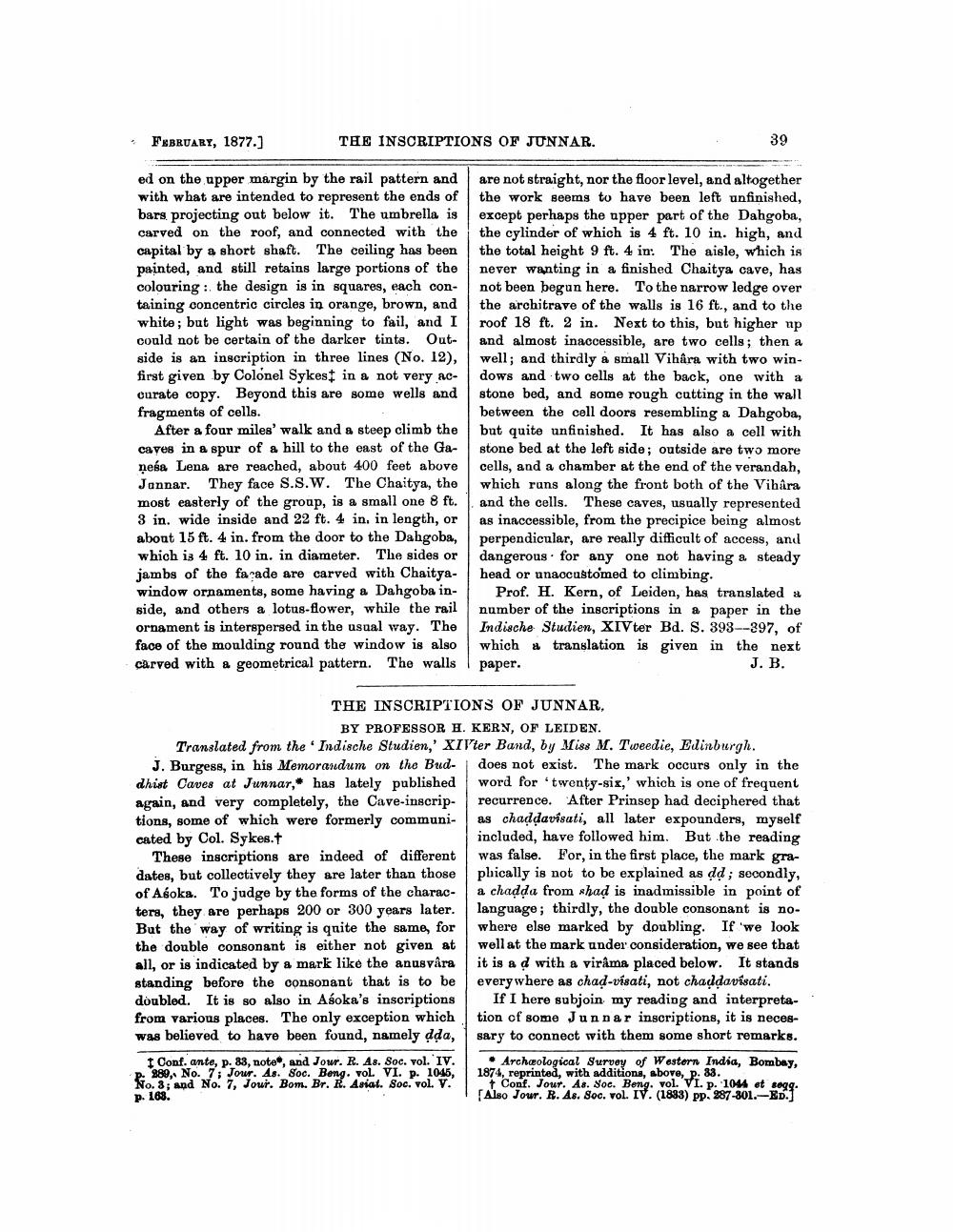________________
•
FEBRUARY, 1877.]
THE INSCRIPTIONS OF JUNNAR.
39
ed on the upper margin by the rail pattern and with what are intended to represent the ends of bars projecting out below it. The umbrella is carved on the roof, and connected with the capital by a short shaft. The ceiling has been painted, and still retains large portions of the colouring: the design is in squares, each containing concentric circles in orange, brown, and white; but light was beginning to fail, and I could not be certain of the darker tints. Outside is an inscription in three lines (No. 12), first given by Colonel Sykesi in a not very accurate copy. Beyond this are some wells and fragments of cells.
After a four miles' walk and a steep climb the caves in a spur of a hill to the east of the Gaņeša Lena are reached, about 400 feet above Jannar. They face S.S.W. The Chaitya, the most easterly of the group, is a small one 8 ft. 3 in. wide inside and 22 ft. 4 in. in length, or about 15 ft. 4 in. from the door to the Dahgoba, which is 4 ft. 10 in. in diameter. The sides or jambs of the facade are carved with Chaitya- window ornaments, some having a Dahgoba inside, and others a lotus-flower, while the rail ornament is interspersed in the usual way. The face of the moulding round the window is also carved with a geometrical pattern. The walls
are not straight, nor the floor level, and altogether the work seems to have been left unfinished, except perhaps the upper part of the Dahgoba, the cylinder of which is 4 ft. 10 in. high, and the total height 9 ft. 4 in. The aisle, which is never wanting in a finished Chaitya cave, has not been begun here. To the narrow ledge over the architrave of the walls is 16 ft., and to the roof 18 ft. 2 in. Next to this, but higher up and almost inaccessible, are two cells; then a well; and thirdly a small Vihara with two windows and two cells at the back, one with a stone bed, and some rough cutting in the wall between the cell doors resembling a Dahgoba, but quite unfinished. It has also a cell with stone bed at the left side; outside are two more cells, and a chamber at the end of the verandah, which runs along the front both of the Vihara and the cells. These caves, usually represented as inaccessible, from the precipice being almost perpendicular, are really difficult of access, and dangerous for any one not having a steady head or unaocustomed to climbing.
Prof. H. Kern, of Leiden, has translated a number of the inscriptions in a paper in the Indische Studien, XIVter Bd. S. 393--397, of which translation is given in the next paper.
J. B.
THE INSCRIPTIONS OF JUNNAR,
BY PROFESSOR H. KERN, OF LEIDEN. Translated from the Indische Studien,' XIV'ter Band, by Miss M. Tweedie, Edinburgh. J. Burgess, in his Memorandum on the Bud does not exist. The mark occurs only in the dhist Caves at Junnar,* has lately published word for twenty-six,' which is one of frequent again, and very completely, the Cave-inscrip- recurrence. After Prinsep had deciphered that tions, some of which were formerly communi- as chaddavisati, all later expounders, myself cated by Col. Sykes.t
included, have followed him. But the reading These inscriptions are indeed of different was false. For, in the first place, the mark gradates, but collectively they are later than those phically is not to be explained as dd ; secondly, of Asoka. To judge by the forms of the charac- a chadda from shad is inadmissible in point of ters, they are perhaps 200 or 300 years later. language; thirdly, the double consonant is noBut the way of writing is quite the same, for where else marked by doubling. If we look the double consonant is either not given at well at the mark under consideration, we see that all, or is indicated by a mark like the anusvara it is a d with a viráma placed below. It stands standing before the consonant that is to be everywhere as chad-vísati, not chaddavísati. doubled. It is so also in Asoka's inscriptions If I here subjoin my reading and interpretafrom various places. The only exception which tion of some Junnar inscriptions, it is neceswas believed to have been found, namely dda, sary to connect with them some short remarks.
I Conf. ante, p. 83, note, and Jour. R. 48. Soc. vol. IV. Archæological Survey of Western India, Bombay, P. 889, No. 7 Jour. As. Soc. Bong. vol. VI. p. 1045, 1874, reprinted, with additions, above, p. 83. No. 3; and No. 7, Jour. Bom. Br. R. Asiat. Soc. vol. V. t Conf. Jour. As. Soc. Beng. vol. VI. p. 1044 et sogg. p. 163.
[Also Jour. R. As. Soc. vol. IV. (1833) pp. 287-801.-Ed.]




